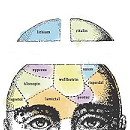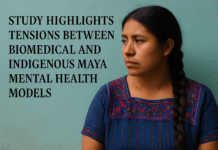Many people are traumatised rather than healed by their interaction with mainstream mental health services, especially their admission to a psychiatric inpatient unit. Concurrently, many mental health professionals carry a burden of their own trauma and are not healthy individuals.
How can we build a truly healing hospital that would love, nourish and heal all within, including the professionals who work there?
In this article a British-trained medical specialist, turned trauma therapist, and an indigenous Western-trained Māori doctor in New Zealand, who have both quit the mainstream medical system to work as trauma therapists, share their bicultural vision for a healing hospital.

What do we mean by healing?
Healing means ‘to transcend suffering’, to be in the process of finding greater wholeness. Trauma fragments our being as we disconnect from our experiences, suppress our feelings and hide away our wounded parts. The process of healing allows all of our parts to come together in authentic wholeness, offering our gifts to the world. The journey of healing is lifelong and it’s a process rather than a destination.
Healing is not the same as cure. We may be cured, but not healed, and healed but not cured. For instance, medical treatment might cure us of cancer but leave us traumatised, fearful, and in pain. And at the end of life, when modern medicine has no more treatments to offer, we can find peace and resolution through healing.
When we truly heal our emotional wounds, many physical diseases may ease or disappear. Trauma is a direct cause of epigenetic changes, inflammation, hormonal imbalance, and physiological stress that is the underlying cause of much ‘dis-ease’. Dr Gabor Mate, an international authority on trauma and author of The Myth of Normal, echoes spiritual teacher Carolyn Myss in explaining how “our biography becomes our biology.” When trauma is healed, so do our bodies. The major failing of modern medicine is to neglect these profound connections and to treat patients as if they are just biological machines.
The human needs for healing
Western society is creating an epidemic of emotional distress and mental illness, exacerbated by the COVID pandemic, social isolation, and the further fragmentation of communities. We cannot address chronic physical health problems without first attending to emotional and mental wellbeing.
What do humans need to heal from mental distress and illness?
- Loving kindness and compassion
- Human connection and healing touch
- Validation of all of our mental experiences (not dismissing them as pathology)
- Non-judgment and non-labelling
- A safe, healing physical environment
- Nourishing fresh food
- Connection to nature
- Exercise
- Holistic approaches to health and wellbeing—supporting mind, body, spirit, and relationships
- A sense of community
- A sense of personal agency and self-worth
- Personal meaning and purpose
- Being part of something bigger than ourselves (spirituality)
Furthermore, our approach and therapies need to treat the root causes of mental distress and illness—especially trauma and environment—and not just treat the symptoms, or numb the pain.
In a typical inpatient mental health unit, patients are systematically denied almost all of these healing requirements. Patients are objectified, labelled, pathologized, treated with detachment, denied loving touch, separated from community, served unhealthy food, separated from nature, locked in a prison-like environment, treated with potentially harmful drugs, and stripped of power.
Psychiatric illnesses are diagnosed and treated according the Diagnostic and Statistical Manual (DSM), now in the 5th Edition. However, leading psychiatric researchers in a study published in Psychiatry Research in 2019 concluded that “psychiatric diagnoses are scientifically worthless as tools to identify discrete mental health disorders.”
Lead researcher Dr Kate Allsopp, University of Liverpool, said: “Although diagnostic labels create the illusion of an explanation they are scientifically meaningless and can create stigma and prejudice. I hope these findings will encourage mental health professionals to think beyond diagnoses and consider other explanations of mental distress, such as trauma and other adverse life experiences.”
Professor Peter Kinderman, University of Liverpool, said: “This study provides yet more evidence that the biomedical diagnostic approach in psychiatry is not fit for purpose.”
Leading trauma experts, such as Dr Gabor Mate, say that almost all mental distress and mental illness, including addiction, is caused by trauma and adverse life experiences. Yet the mainstream mental health services have adopted a medical model that locates mental illness as a chemical imbalance in the brain, not the end result of the person’s life experiences and environment.
We know that the mental health status of our nation—New Zealand—has steadily deteriorated over recent years, accompanied by world-leading rates of youth suicide, and dramatic increases in the demand for mental health services. Our NZ mental health system is in crisis, despite large increases in funding, and we need new approaches that have proven benefits in mental wellbeing and resilience.
The existing mental health hospitals are radically failing our communities despite the dedication and hard work of those working within them. They too, are suffering moral injury, burnout and despair because they know the system is not working.
We just need to start again and build an approach to mental health that is trauma-informed, holistic, loving and healing. That must include the built environment of care, the shape of our clinics and hospitals. A healing hospital would be a place of respite and healing for all those who work to support the health and wellbeing of others: health professionals and healers of all kinds, especially in the field of mental health.
A foundational healing therapy—based on neuroscience
Traditional medical treatment reduces patients to passive recipients of drugs or physical therapies. Yet the latest advances in neuroscience show that humans have an innate capacity to rapidly heal their trauma, thereby relieving mental distress and physiological stress.
Both authors are Certified Practitioners and Trainers in Havening Techniques, developed by Dr Ronald Ruden in the USA, which offer a revolution in mental health therapy (havening.org). A detailed scientific theory describes the neuro-anatomical pathways and molecular mechanisms by which trauma is stored in the brain. The same molecular mechanisms can be set in reverse to permanently erase trauma, in a process typically taking 15 to 20 minutes.
This psychosensory healing process is activated by specific forms of soothing touch, which activate newly discovered C-fibre Tactile Afferent nerves in the skin. We have evolved these nerves as part of human social connection and behaviour and touch is essential for our survival. The anatomy and physiology of this touch system has been ignored by medical science.
As an example of Havening Techniques, see this short video of a client with a severe trauma—an armed holdup in South Africa—erasing her traumatic memory in just twelve minutes.
The essence of this therapy is working with client stories and experiences using very precise diagnostic criteria to identify and erase moments of encoded trauma. The pre-conditions for this rapid healing are safety for the client, compassionate presence by the practitioner, and specific forms of soothing touch (which may be applied by the practitioner or self-applied by the client).
In our experience, Havening is an effective therapy for a wide range of mental health conditions including chronic depression, anxiety, panic disorders, phobias, PTSD, traumatic events, chronic pain, addictions, and many other conditions. Because Havening addresses the root causes of mental illness—trauma—it is not necessary to stigmatise clients with any diagnostic labels. In the author’s experience, even the intrusive voices of schizophrenia and the severe social phobia of autism can be greatly helped with Havening.
The scientific theory predicts exactly how encoded trauma can cause self-limiting beliefs, intrusive memories, autonomic stress reactions, localised somatosensory symptoms, and emotional reactions. The validity of the scientific theory is demonstrated by the rapid change in client’s physiology during therapy. A scientific trial showed significant and prolonged changes in markers such as blood pressure and cortisol levels after a single session of Havening. A more recent randomised, controlled trial (2023) showed remarkable increases in client resilience also after one session of Havening.
As Certified Trainers of Havening Techniques, we have trained many counsellors, therapists, psychologists and doctors in this healing method and they are astounded to witness the results in their clients and patients.
Sadly, the medical research establishment is strongly biased against any genuine innovation in medical treatment and there are formidable barriers to formal research:
- Ethical committee opposition to ‘untried’ therapies
- Unwillingness of researchers to commit years to a study in a truly innovative treatment
- Difficulty in getting research funding
- Academic framing of research design, which ‘abstracts’ the real-life results
- Great difficulties in getting publication of completed studies owing to the bias and vested interests of peer reviewers
To overcome the barriers of conventional research and to measure outcomes that directly relate to real-life improvement in clients, we propose to democratise the research process by gathering outcome data directly from clients (in our view, the only valid outcome measure in mental health therapies). We are investigating the use of the Quantified Citizen App, set up by a group of researchers in Canada, to enrol many thousands of clients in outcome research.
An holistic approach to healing
Together with Havening Techniques, a healing hospital would integrate many holistic approaches to healing:
- Cultural and spiritual support, integration
- Group work and individual therapy sessions
- Body work, breath work, art therapy, dance, narrative therapy, and other modalities
- Psychodynamic approaches, counselling and positive psychology
- Nourishing fresh food served from the kitchen garden: all residents will participate in gardening, harvesting, preparation and sharing of meals
- Opportunities for individual and group exercise
- Connection to nature
- Integration with a wide range of community activities
- Peer support and learning to become a healer
- A stunningly beautiful building, constructed of natural materials, and designed to support healing
- A beautiful rural setting with water views, native bush, gardens and walks
Dissolving patient-professional boundaries
In our practice as a trauma therapists we see many clients heal their trauma, transcend their suffering, and completely change their lives; these positive results are intensely gratifying and joyful to witness. However, the greatest gratification is seeing clients take the gifts of their suffering forward in service to others: gifts of deep empathy, compassion, humility, non-judgment, understanding, and a profound faith in the human capacity for healing. The very best healers are those who have healed their own trauma, not necessarily those with clinical qualifications.
Our philosophy is:
- Every person is seeking healing, on a lifelong journey
- Every person can offer the gift of healing
- Every person is seeking new knowledge
- Every person can be a teacher
We do not distinguish between the teacher and the student, the healer and those seeking healing—all are one the same journey; all will sit together in the circle and heal as a community of peers.
Kaupapa Māori (indigenous philosophy) and Havening as a way to address the impacts of colonisation and trauma.
How does Havening relate to kaupapa Māori and the impacts of colonisation?
Dr Kamaia Pere writes, “As a Māori doctor, and someone who has lived through the impacts of colonisation, intergenerational trauma and human suffering, I see Havening and it’s role for humanity as a tool to reconnect back to tino rangatiratanga (self-determination) for all peoples, allowing ourselves to control our own culture, aspirations and destiny.
Havening practice restores our natural capacity to heal as it allows each of us—safely, effectively and rapidly—to honour and release the impacts of trauma: intergenerational trauma, our own lifetime trauma, and the impacts of colonisation, which are stored inside our brains, our minds, and our bodies, while coming out miraculously transformed and, with practice, empowered.
Colonisation can mean many things to many different people, but the impact of this process and how it shapes our world views are inseparable. The process and action of colonisation is based on the ideology that we are separate individuals, disconnected from nature, from our our pasts, and in direct competition with one another.
These beliefs and mental frameworks weave through and are embedded into the current health, education and social systems we see today, but also shaping individual human beings who are deeply stressed, traumatised, feeling ‘never enough’, and trapped in a cycle of continual suffering.
Linda Tuhiwai Smith’s research, ‘He Oranga Ngākau’, looking at the impacts of trauma on Māori and other indigenous people states “Trauma alters our practices, feelings, identities and our relationships. It alters our physical bodies. It affects our sense of place and worthiness, our feelings of value and of being settled.”
While there is a growing understanding of colonisation, trauma and the impact this can have on health and wellbeing, there is little successful application of therapies to heal the trauma within ourselves, and I believe this is where Havening comes in.
There are many aspects of the health system that are not serving humanity: our needs to become emotionally resilient, empowered beings who are living and embodying wellbeing. And when as health professionals and healers we think about creating a new system of healing, it is important we do so on the premise of healing our own trauma, and reframing our minds into a kaupapa Māori (or wholistic) approach, before we start inviting new structures.
Further, to loosely quote Linda Smith at a Pacific Region Indigenous Doctors Congress 2017, “Even if we remove these systems with the ideal to create new ones, the same minds will perpetuate and replicate the system we were moving away from.”
In a healing hospital everyone is invited to heal—the carers and those seeking care, alike—and like Mahatma Ghandi said, “Be the change they wish to see in the world”.
Key indigenous Māori concepts are:
Whakawhanaungatanga: making connections with our ancestry, our stories, our place in the world and how we relate to each other.
Manaakitanga: everyone who enters the centre, feels welcome, relaxed, safe, heard and cared for.
Kanohi ki te kanohi (face to face): there is no hierarchy, we are at the same level and the client leads their own healing journey.
Whatumanawa: we create a safe place to explore and encourage the expression of emotions
Mana ake: Acknowledging the unique identity of the individual and whanau (extended family)
Waiora: seeing the individual as a whole in connection to the whole whanau, community and culture
Tino Rangatiratanga: allowing and encouraging the client to control their own culture, aspirations and destiny.”
Ecologically sustainable and regenerative
Our world is enmeshed in multiple simultaneous crises: the climate emergency, ecological collapse, economic instability, inequality and poverty, the breakdown of community, a food system that poisons many, a health system that promotes the treatment of chronic illness, rather than healing disease, and an education system that immerses people in the beliefs that are destroying the world.
In order for the world and our communities to survive, we need to radically adapt our ways. A healing hospital would adopt philosophies and principles of design, construction, material use, energy and water use, regeneration of the natural environment and all other measures that protect and heal our biosphere.
A healing hospital will be built, as much as possible, with natural materials sourced locally: earth, stone and timber. We have talked with an architect who did a Masters Degree in how architecture can create healing spaces.
The healing hospital should ideally be built and shaped by the community drawing on the skills and ideas of many artists, sculptors, healers, spiritual leaders, builders, craftsmen, gardeners, and others—not a commercial construction abstracted from the local community.
The best architecture would be organic and flowing, resembling the forms of living things, not like the fortresses of modern hospital buildings. We can draw on the inspiring work of many pioneers who build cancer hospitals and hospices as places of healing, not high technology. We can find the best local experts in permaculture, environment restoration, and food production.
Continuous research evaluation
It is shocking that New Zealand spends billions of dollars on mental health care without actually measuring outcomes. There are many well-validated instruments for self-reported measures of anxiety, depression, mental wellbeing, life satisfaction, and overall level of physical and social functioning.
Unlike the mainstream mental hospitals, a new healing hospital should have outcomes measured continuously, based on self-reported measures of those receiving care. We can forge partnership with academic researchers to prove the new way is better. The real-life outcomes will be reported by the people being served, not the abstracted results of randomised controlled trials using measures from a medical model.
In short, we would hope to prove that holistic, healing approaches can cure people of mental illness, can radically change the trajectory of their lives, can build resilience and wellbeing, and can create many new healing practitioners to serve our communities.















Absolutely beautiful concept. I wish you all the best in this most meaningful endeavor.
Report comment
I’m pretty sure places like this already exist for the very wealthy; they’re called luxury spas. Who else could foot the bill?
But the real challenge isn’t access to money for fancy “healing” vacations. The real challenge is changing the way people see themselves and how they relate to each other in everyday life.
Report comment
People don’t need “therapy”. They need spiritual solace.
Report comment
Thank you, Birdsong.
Havening cannot justifiably be labeled as an “effective therapy for a wide range of mental health conditions such as chronic depression, anxiety, panic disorders, phobias, PTSD, traumatic events, chronic pain, and addictions” if we reject the very existence of ‘mental illness.’ As highlighted by the Council For Evidence Based Psychiatry (2024, http://www.cepuk.org), there are no biological tests or brain scans that confirm psychiatric diagnoses, thus undermining the legitimacy of these labels. How can Havening claim to address issues that are essentially classified as quasi-diagnoses? The authors’ insinuation that chronic pain and traumatic events stem from a ‘mental illness’ is misguided and problematic.
Additionally, psychological distress arises from reasons that render it incurable by therapy, as noted by Smail (1987). This reality suggests that Havening may simply be another paternalistic approach aimed at controlling vulnerable individuals and undermining their autonomy.
Report comment
I’m sick of people cashing in big time on the deeply flawed concept of “mental illness”. But I have to say I think the Havening technique might help some people calm down neurologically at least temporarily. I don’t remember the serious accident I was in or most of the week and a half in the hospital that followed, but I do recall my sister asking me if I wanted her to scratch my arm. It relaxed me so much I fell right to sleep.
Report comment
Hi Cat, I hear the passion behind your comment. I am sorry if my wording implied that I believe in ‘mental illness’ as a pathology. Havening Techniques specifically avoids all reference to mental health diagnoses with the exception of ‘trauma’, which is not an illness but is an adaptive response to traumatic life events, which can cause lifelong difficulties. For instance, I carried a terrifying fear of abandonment for more than 50 year, which greatly impacted on the relationship with my wife. This fear arose out of the trauma of being abandoned at boarding school, age ten. The problem was permanently abolished in 15 minutes of Havening. In my experience of helping more than a thousand clients in my trauma clinic, many of the life difficulties that get labelled as ‘anxiety, depression, PTSD, phobias, personality disorders, addictions, and many others, are the result of trauma and symptoms can dramatically improve when the trauma is healed. The effects seem to be permanent and are based on a very detailed scientific theory about how trauma is stored in the brain, and can be rapidly erased
Report comment
Dear Robin,
Your statement regarding Havening as an “effective therapy for a wide range of mental health conditions” raises significant concerns. This phrasing implies your adherence towards the legitimacy of ‘mental illness’.
Your assertions regarding the efficacy of Havening, such as “in my experience”, “trauma is healed” and “seem to be permanent”, lack rigorous scientific backing—please provide the empirical data that supports these claims. If a person’s trauma was healed, why would their symptoms only “dramatically improve” rather than be eliminated? Does this not suggest that healing did not occur whilst manifestations of trauma are still present?
Furthermore, it’s crucial to note that “a very detailed scientific theory” requires empirical validation to be considered scientifically robust. The term ‘theory’ then becomes redundant in the presence of substantiated evidence.
Where, precisely, is “trauma stored in the brain” and how can it be “rapidly erased”? Trauma cannot be healed or eradicated in the same manner as a bacterial infection; it is not simply a medical condition that can be eliminated through treatment. Counterarguments are welcome.
Kind regards,
Cat
Report comment
Dear Cat
Thank you for your interest. I will try to answer your questions.
Havening is based on the scientific mechanism described in this published paper:https://www.sciencedirect.com/science/article/pii/S1550830718301848
The efficacy is proven in two randomised controlled trials (RCT’s) plus numerous clinical observations by 1,100 Certified Havening Practitioners. In my own clinic I have used it in more than a thousand clients.
Trauma is stored in the lateral nucleus of the right amygdala, in the first synapse where sensory signals from the thalamus join the amygdala. The neurotranmitter is glutamate, which binds to AMPA receptors. During a traumatic event, the AMPA receptors are rapidly up-regulated to form ‘alarm circuits’ connecting the specific sensory input to our stress reactions, via and autonomic nervous system and other pathways. These receptors are made permanent by the action of an enzyme that phosphorylates a subunit of the AMPA receptor. This reaction occurs in the presence of gamma waves, the highest frequency brain waves. Havening rapidly induces high levels of delta waves (very slow waves) and a frequency-sensitive enzyme dissolves away the phosphate bond allowing the receptors to them be removed from the post-synaptic membrane. This reaction occurs within minutes and correlates with the client’s experience of the trauma healing.
Trauma is pleural, not singular. We all have layers of trauma and it can’t all be healed. However, a singular trauma – such as a violent rape – can be completely erased in minutes. At the end of that process, the client is unable to connect to the traumatic images, there is no emotional charge to the memory, no stress reaction, and the previous triggers (such as the sight of a man) are abolished. Only the objective, factual memory remains. If enough of the trauma is healed, the client becomes resilient and other traumas don’t affect them day to day.
I don’t expect anyone to believe this until they have witnessed it for themselves, because it seems ridiculous. No RCT is needed to persuade someone that their life has radically changed for the better after one session of therapy. I have been using this technique for seven years and 99% of my clients have never been able to reactivate a trauma that has been erased (checking back with clients up to six years ago).
Trauma is not an illness but traumatic memories can cause severe life difficulties and lie at the root of symptoms that get labelled as mental health ‘conditions’.
This evening we have the premiere of a film documentary made about this work. When you see the testimony of previous clients, students and practitioners (and you will probably have tears in your eyes because the stories are so moving), then you will become curious.
Kind regards, Robin
Report comment
So tell us about the method!
Report comment
See havening.org
Report comment
Dear Robin and Steve,
The paper Robin mentioned describes a POSSIBLE mechanism by which traumatic memory encoding occurs, whilst conceding that the “biological and clinical expressions of traumatisation are complex and INCOMPLETELY understood.” Despite the limitations in understanding trauma, the paper proposes a technique called Havening, which involves an individual recalling their trauma, rating their distress, and visualising walking up a staircase whilst counting. They are then touched by the ‘practitioner’ on their face, palms and arms. Afterwards, they hum a familiar tune, have their arms touched again and look at the back of their eyelids. According to the paper, the traumatic memory is then “resolved metaphorically”. What this means, I am uncertain. However, I speculate that it must involve a form of financial transaction.
The entire process of Havening resembles season one episode two of Spongebob Squarepants titled Bubblestand, in which Spongebob performs various absurd motions to teach Patrick Starfish how to blow a bubble using detergent and a bubble wand (perhaps this is where the Havening Technique found its inspiration).
Finally, the paper SPECULATES that the process generates a delta brain wave, which has an electroceutical effect and MAY lead to the deencoding of the event by synaptic depotentiation. Paradoxically, it also attests to the evolutionary advantage of permanently encoding a threat by examining how it “allows us to become rapidly aware of potential danger through the mechanism of pattern recognition as the brain seeks similarity in novel circumstances”(https://www.sciencedirect.com/science/article/pii/S1550830718301848). Thus, in contradiction, the benefit of recalling trauma to prevent further trauma makes the Havening technique not only void but also dangerous.
Overall, I would recommend watching the Spongebob episode I mentioned (https://www.paramountplus.com/au/shows/video/LmSrfX6Xsvm_FwfDEHAGGoSTEXN0RrwQ/) as it too has the POTENTIAL to “metaphorically resolve” the absurdity of the referenced journal article. “Science is the belief in the ignorance of experts” (Feynman, R.).
Kind regards,
Cat
Report comment
Dear Cat
I used to be just like you (smile). With a degree in engineering from a prestigious university and then 14 years of medical training, I was righteous in defending what I knew to be science, evidence and truth. But, like you, I challenged the medical model, opened myself to other kinds of knowledge, and eventually quit my medical career after 40 years of practice. This paper offers a holistic approach to healing which radically challenges the medical model.
So here’s a question meant kindly: What hidden part of you is so angry that you have to mock and deride my attempt to answer the questions you posed? What part of you is so desperate to be right?
If you can honestly answer those questions, you will do well in life.
All the best, Robin
Report comment
Dear Robin,
It might be more effective to focus on the robustness of your evidence instead of resorting to ad hominem attacks, which may be interpreted as gaslighting.
Kind regards,
Cat
Report comment